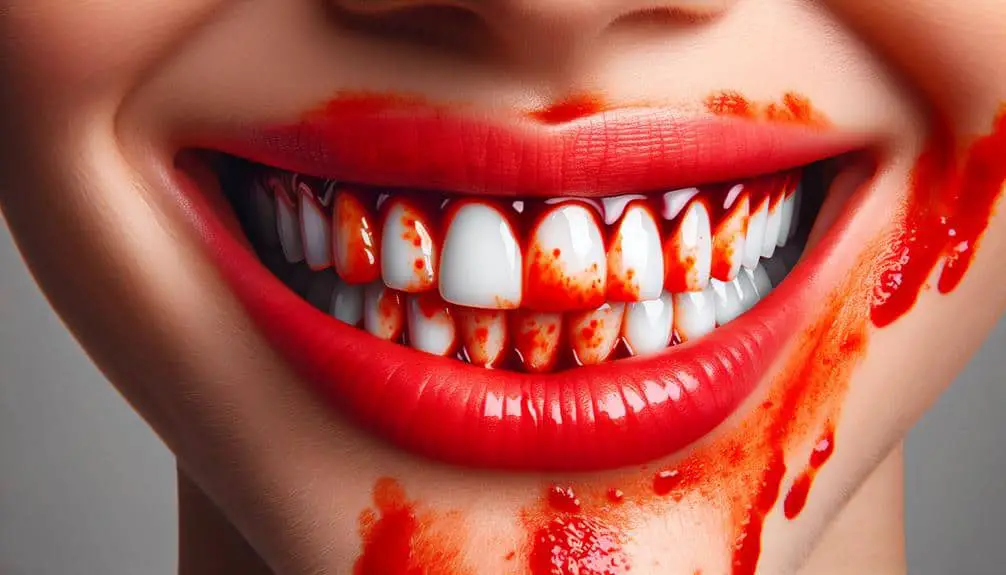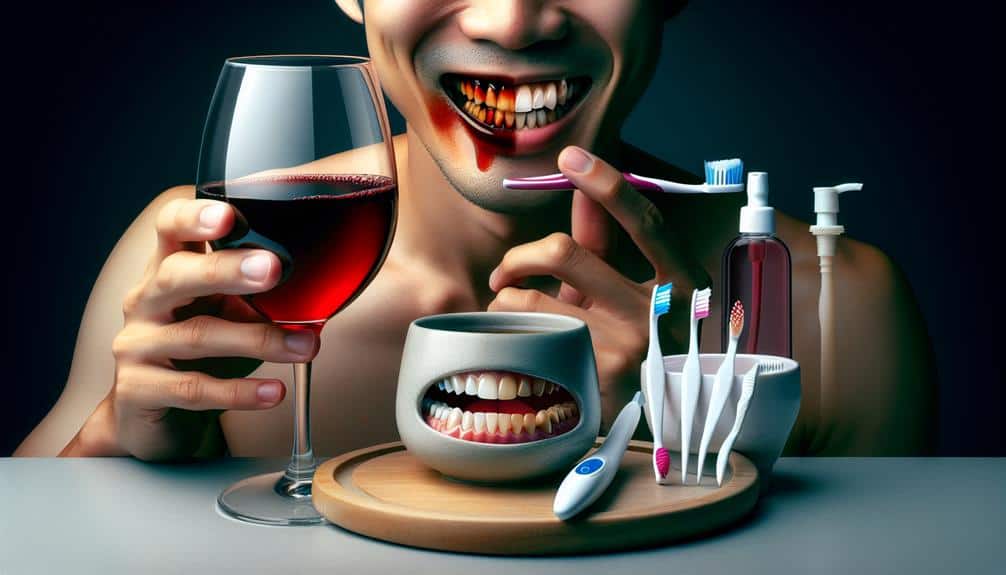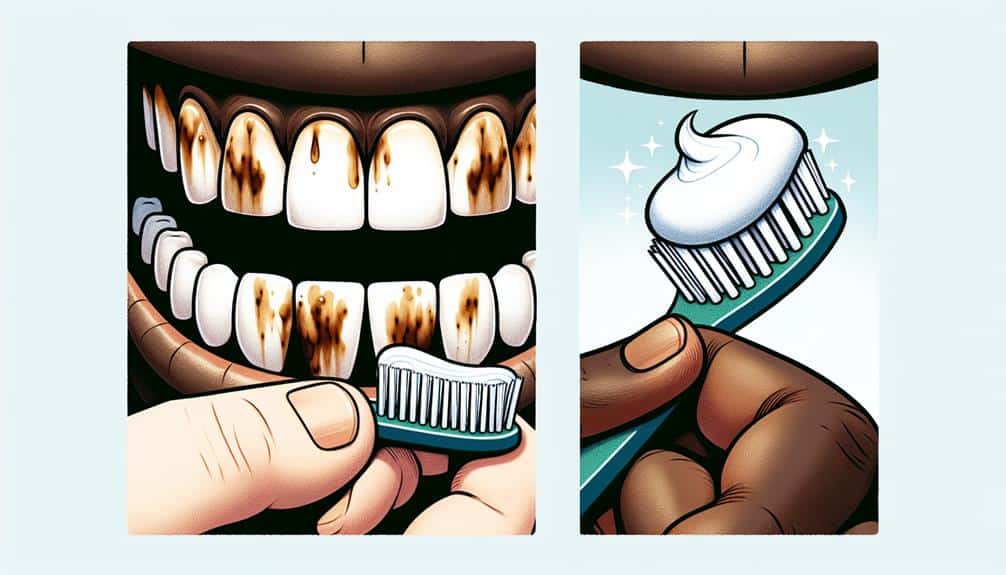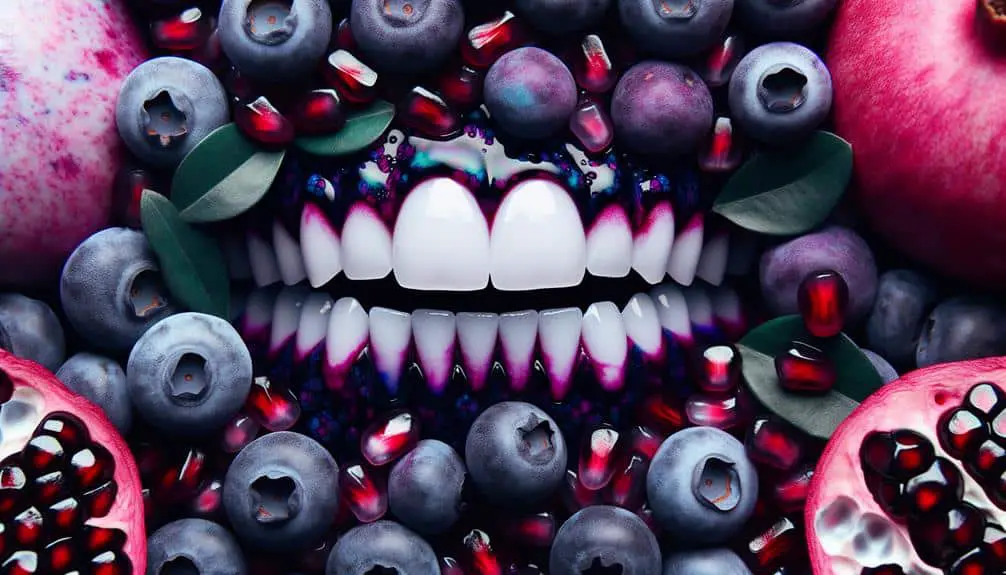When red pasta sauce meets your teeth, its important nature weakens enamel, paving the way for erosion and exposure of yellowish dentin, which can lead to discoloration. The pigments in tomatoes, such as lycopene and chlorophyll, have a talent for binding to dental surfaces, further contributing to staining. Tannins found in red wine exacerbate this effect by binding to proteins in saliva. The abrasive texture of the sauce also plays a role, causing micro-abrasions on enamel, which chewing can enhance. Understanding these interactions is essential for effective stain prevention. Maintaining good oral hygiene practices can help shield your enamel from discoloration.
Key Points
- The acidity in red pasta sauce weakens enamel, making teeth vulnerable to staining.
- Pigments like lycopene and carotenes in tomatoes bind to teeth, causing discoloration.
- Tannins in red wine can stain enamel by binding to proteins in saliva.
- Gritty particles in pasta sauce can cause micro-abrasions on enamel, enhancing staining.
- Enamel erosion from acidic sauces exposes yellowish dentin, leading to teeth discoloration.
Acidity of Red Pasta Sauce
The importance of red pasta sauce acidity in causing teeth discoloration can't be overstated. The low pH level of the sauce can result in tooth erosion, which is the gradual wearing away of the outer enamel layer of the teeth. Enamel serves as the tough, protective coating of the teeth that helps maintain their strength and color. When the enamel is eroded, it exposes the underlying dentin, which has a yellowish hue, leading to teeth appearing discolored.
Tooth erosion caused by the acidity of red pasta sauce can also make the teeth more vulnerable to staining from other pigmented foods and beverages. It's vital to safeguard the enamel of your teeth to prevent discoloration. Upholding good oral hygiene practices such as regular brushing with fluoride toothpaste, flossing, and utilizing mouthwash can help shield the enamel.
Moreover, consuming acidic foods in moderation and rinsing your mouth with water after consuming them can help lessen the impact of acidity on your teeth. Proper enamel protection is essential in preventing teeth discoloration brought about by red pasta sauce.
Pigments in Tomatoes
Pigments present in tomatoes are key contributors to teeth discoloration when consuming red pasta sauce. The vibrant red color of tomatoes comes from various pigments, such as lycopene, carotenes, and chlorophyll, which have the potential to adhere to the enamel of your teeth, leading to dental staining.
Understanding the role of tomato pigments in causing teeth discoloration can help you make informed choices about your diet and oral hygiene practices.
- Lycopene: This powerful antioxidant not only gives tomatoes their red hue but also has a high affinity for binding to dental surfaces, contributing to teeth staining.
- Carotenes: These pigments, responsible for the orange color in tomatoes, can also adhere to teeth and cause discoloration over time.
- Chlorophyll: While chlorophyll is mainly associated with the green color in plants, it can contribute to teeth staining when present in high concentrations in tomatoes.
Being aware of the tomato pigment content in red pasta sauce can help you take proactive steps to mitigate dental staining and maintain a bright smile.
Tannins in Red Wine
Among the various factors contributing to teeth discoloration, a significant one to take into account is the presence of tannins in red wine. Tannins are natural compounds found in grape skins, seeds, and stems, which are also present in red wine. These compounds are known for their astringent properties and have the potential to cause staining on tooth enamel. When you consume red wine, the tannins can bind to the proteins in your saliva and create a thin film on your teeth. Over time, this film can lead to discoloration, making your teeth appear darker or yellowish.
The effects of tannins and staining from red wine can be exacerbated when combined with other staining agents, such as pigments in foods like red pasta sauce. To minimize the impact of tannins on your teeth, consider drinking water while consuming red wine to help wash away the tannins and reduce their contact with your teeth. Additionally, practicing good oral hygiene habits, like brushing and flossing regularly, can help prevent or reduce teeth discoloration caused by tannins in red wine.
Abrasive Nature of Pasta Sauce
To understand the impact of the abrasive nature of pasta sauce on teeth discoloration, consider how its texture and composition can contribute to enamel wear and staining. Pasta sauce's abrasive effects on teeth are primarily due to its acidic nature and the presence of small, gritty particles that can physically wear down enamel over time.
Here are three key points to explore further into this topic:
- Acidic Content: The acidity of pasta sauce can weaken the enamel, making it more susceptible to staining from pigmented compounds present in the sauce.
- Gritty Particles: Abrasive particles in pasta sauce, such as spices and tomato seeds, can act like sandpaper on the enamel, causing micro-abrasions that lead to discoloration.
- Mechanical Action: The act of chewing and the movement of pasta sauce in the mouth can further enhance its abrasive effects, promoting enamel erosion and staining.
Understanding these factors is essential for implementing effective staining prevention strategies and maintaining ideal oral health.
Interaction With Tooth Enamel
The interaction of red pasta sauce with tooth enamel can lead to discoloration and erosion due to its acidic and abrasive properties. Enamel erosion occurs when the acids in the sauce weaken the enamel, making it more susceptible to damage. This erosion can result in thinning of the enamel, exposing the yellowish dentin underneath, which can lead to discoloration of the teeth. To prevent staining and enamel erosion caused by red pasta sauce, it's essential to maintain good oral hygiene practices.
Staining prevention can be achieved by brushing your teeth after consuming foods high in acidity, like red pasta sauce. Using a fluoride toothpaste can help strengthen the enamel and protect it from erosion. Additionally, consider drinking water or chewing sugar-free gum after eating acidic foods to help neutralize the acid in your mouth. Regular visits to the dentist for professional cleanings and check-ups are also vital in preventing enamel erosion and maintaining a healthy smile.
Frequently Asked Questions
Can Teeth Discoloration From Red Pasta Sauce Be Prevented by Using a Specific Type of Toothpaste or Mouthwash?
To prevent teeth discoloration from red pasta sauce, choose a toothpaste with whitening properties. Opt for a mouthwash that targets stains. Good dental care, including regular brushing and flossing, can help maintain a brighter smile even after indulging in red sauce.
Are There Any Natural Remedies or DIY Methods to Remove Stains Caused by Red Pasta Sauce From Teeth?
Want to banish red pasta sauce stains from your teeth? Try natural remedies like baking soda or hydrogen peroxide for DIY home teeth whitening. These methods can gently remove discoloration without harsh chemicals.
How Long Does It Take for Teeth Discoloration From Red Pasta Sauce to Fade on Its Own?
Teeth discoloration from red pasta sauce can take varying durations to fade naturally. The staining timeline is influenced by personal oral care habits and the severity of the stains. Consistent brushing and dental cleanings can expedite the fading process.
Are There Any Long-Term Effects on Dental Health From Frequent Consumption of Red Pasta Sauce?
To prevent long-term impacts on dental enamel from frequent red pasta sauce consumption, consider regular dental cleanings and using a straw to minimize staining. Protect your dental health; safeguard your smile.
Can Professional Dental Cleanings Help Remove Stubborn Stains Caused by Red Pasta Sauce?
Professional dental cleanings can effectively remove stubborn stains caused by red pasta sauce. However, for more persistent discoloration, teeth whitening procedures might be necessary. Consult your dentist for personalized advice on the best treatment alternatives for you.



